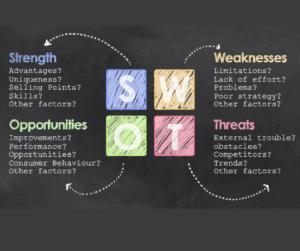 As its name suggests a S.W.O.T. analysis is a tool for examining the positives and negatives within your business as well as in the outside environment. Strengths and Weaknesses are often defined as identifying issues internal to the businesses, while Opportunities and Threats identify issues external to the business. It can be helpful to frame the exercise this way, though clearly that will be specified a little differently if you are doing a S.W.O.T. analysis on something like your organizational chart as opposed to your market position. You can hire an outside professional to perform a S.W.O.T. analysis, but you can also use S.W.O.T. with your management team to do a quick check-in of any aspect of your business, from strategic planning to a single project. Think of the S.W.O.T. format as a simple way to direct a conversation that will reveal the most urgent problems to be solved and actions to be taken.
As its name suggests a S.W.O.T. analysis is a tool for examining the positives and negatives within your business as well as in the outside environment. Strengths and Weaknesses are often defined as identifying issues internal to the businesses, while Opportunities and Threats identify issues external to the business. It can be helpful to frame the exercise this way, though clearly that will be specified a little differently if you are doing a S.W.O.T. analysis on something like your organizational chart as opposed to your market position. You can hire an outside professional to perform a S.W.O.T. analysis, but you can also use S.W.O.T. with your management team to do a quick check-in of any aspect of your business, from strategic planning to a single project. Think of the S.W.O.T. format as a simple way to direct a conversation that will reveal the most urgent problems to be solved and actions to be taken.
If you are going to do a S.W.O.T. analysis as a group exercise or with input from key people, start by identifying the relevant individuals. They might be your executive team, or your managers, or it might be the people who lead in important areas whether they manage anyone or not. Prior to the meeting, ask them to bring their ideas about what currently is and isn’t working for the particular issue or aspect of your business you are examining.
Once everyone is together, start by having a discussion about what is working (Strengths). Jot down all those statements as they are made. Emphasize that there are no right or wrong answers; all opinions are valid. Don’t edit at this point or you’ll shut down the conversation. Next list everything that isn’t working (Weaknesses). Then do the same for Opportunities and Threats. Sometimes people have trouble distinguishing between a Weakness and a Threat. This is where the internal (Weakness) vs. external (Threat) distinction can be particularly helpful.
Once your chart is complete, identify the most important items to take action on. As you examine the chart, you might find that there are redundancies. Some items might even appear in different categories. But that’s why it’s really important not to edit too early in the process. Items that appear multiple times or in different places on the chart are likely to be important and deserve further discussion. Places where you see similarities or common themes should be your highest priorities for action.
Excerpted from my book, “Putting Together the Entrepreneurial Puzzle: The Ten Pieces Every Business Needs to Succeed.” Available here on Amazon.
